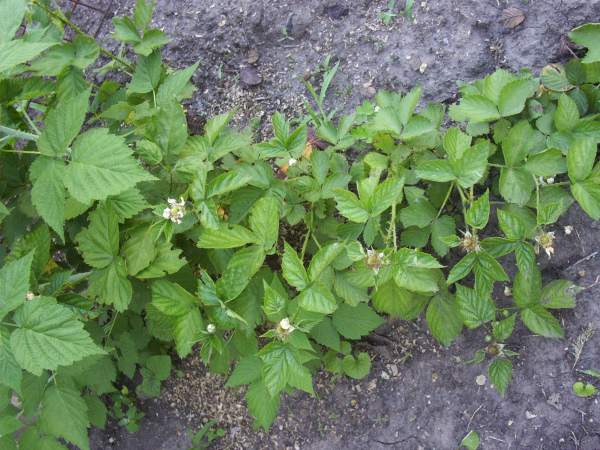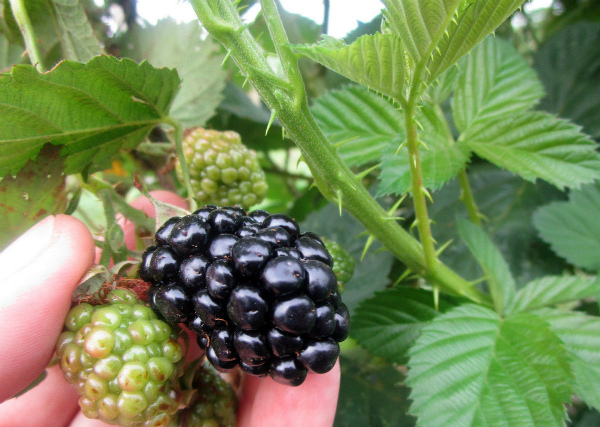Description of the Kiova blackberry variety
Content
Description and characteristics of Kiowa
An American variety emerged from laboratories just 20 years ago «Kiova ", the description of which focuses on the size of the berries, each of them weighs from 12 to 14 g, and individual berries - 20 g. The creators promise the yield to match the berries, with industrial cultivation from 1 hectare you can harvest from 4 to 6 tons. Excellent characterization has been given to this variety in test grows in several states.
Variety Kiova description: refers to kumaniks, that is, its shoots grow straight, do not spread, differ in power not only at the base, but along the entire length, sharp thorns also grow along the entire length. Shoots grow up to 1.5 meters in height or a little more, they do not have to be strengthened on a trellis, but under the weight of the fruit they can be injured, and the wind is quite capable of damaging or confusing them. The bright green leaves also have thorns, the flowers are usually white, less often they acquire a pink tint, and the berries become glossy black when fully ripe.
Large, rounded, somewhat elongated, berries are 2.5 cm in diameter, they have a pleasant sweet taste with some sourness and aroma of wild blackberries. The berries are juicy, at the same time they are dense enough to keep well for several days and not be afraid of transportation. The creators seemed to be deliberately trying to create a variety for commercial cultivation, and they succeeded, judging by the reviews.
Fruiting begins in the second half of July and lasts up to one and a half months. But in the middle lane, it may begin a little later, then there is a danger of losing the remnants of the crop due to early cold weather. The variety is declared as frost-resistant, the creators promise that temperatures down to -23 degrees will not harm it. In our conditions, it is better to cover the aerial part, as is usually done with the vine.
The breeders tried to ensure that the Kiova blackberry seedlings were resistant to fungal diseases, so that rust, anthracnose, white and gray rot, powdery mildew should not bother planting.
Care basics
Blackberry varieties "Kiowa" (or "Kiova") are planted, like any other, in the spring after thawing the soil or in the fall, so that it has time to take root before frost. In our conditions, the spring option is still preferable. The place needs to be found bright with enough sun, it is good if it is protected from strong winds.
In large farms, bushes are planted at a distance of 1.2 m in a row, but if this is a private farm, in which accelerated agricultural technology is not expected, then compacted planting is useless. It is advisable to plant one or more bushes on their sites so that there is 1.5 or 2 m between them.
Before planting, it is advisable to fertilize the soil well or simply add a couple of buckets of compost or humus to the planting pit, add complex mineral fertilizer. The soil should be light and nutritious, if necessary, peat or sand is added to it to reduce the density. If the soil is acidic, then you need to add lime or dolomite flour, you can pour wood ash into the pit. When planting a seedling, you need to make sure that its roots do not come into contact with the fertilizer, this can cause a serious burn.
The planted plant is watered well, it is checked that after compaction of the earth and watering, the root collar is located approximately 1 cm above the ground level. The land around it is mulched with peat, compost or straw, and the shoots are cut over a living bud, leaving no more than 30 cm.
It is still better to strengthen a bush with upright shoots on a trellis - this makes it easier to care for it, it is easier to harvest and prune. He's prickly. In the first year, the shoots will only grow, they can be directed immediately or, as they grow in summer, they can be tied to a support with an open fan so that each branch is clearly visible, all leaves have access to air and the sun. In the fall, they must be carefully removed from the trellis, until they are stiff, shortened by a quarter, rolled up and laid under cover. Although the variety promises frost resistance, our winters are destructive for such plants - it is better not to risk it. Covering the shoots, it is important to find the required degree of insulation, otherwise a lot of heat will do a poor job - the buds can become resistant.
In the spring, they remove the insulation, examine the shoots, cut out the frozen ones, if any, and fix them on the trellis. Now it is better to direct all the shoots in one direction, and in the opposite direction as the replacement shoots grow, which will grow this year. In the fall, the sprouted shoots of the last year must be completely cut off, and the young ones must be removed, shortened and hidden from the cold. This cycle of pruning, tying and covering will need to be repeated annually.
Some gardeners shorten the shoots in the summer, achieving the development of lateral branches in order to increase the yield in this way. Sometimes it helps, but not in the first couple of years, while the bush is still not strong.
It is believed that if you fertilize the bush well when planting, then you can apply the same powerful fertilizers every 3-4 years. But different soil requires a different approach. If the plant needs additional feeding, this will be noticeable by its foliage and the growth rate of the shoots. In this case, in the spring, nitrogen-mineral fertilizers are applied, and during the formation of ovaries - potassium-mineral fertilizers. Some people simply watered with very heavily diluted slurry or bird droppings (even more diluted) in the spring and early summer. If you mulch the ground under the bush with compost or humus, then each watering will carry a portion of top dressing to the roots.
Watering should be sufficient, but not excessive. Blackberries do not like drought, but new varieties are less tolerant of excess moisture. Water stagnation should not be allowed.
Advantages and disadvantages
The undoubted advantages of the variety can be considered excellent large fruits, high yield, frost resistance (albeit relative in our conditions) and immunity to fungal diseases. A long fruiting period can also be considered an advantage if people want to feast on fresh berries for a long time, improving their health, or supply them to the market, increasing their well-being. Harvesting can be done every 3 or 4 days.
But the fruiting of a late ripening variety, stretched out for a month and a half, in our conditions can turn into a slight drawback - the last berries will not have time to ripen before the cold weather. They will have to be sacrificed in order to cut off and remove the shoots for the winter in time. They say that for this reason, up to 10 percent of the harvest is lost in areas with an early arrival of cold weather.
The large-fruited blackberry, a variety of which so recently hit the markets of the world, has one significant drawback - sharp thorns, not only along the entire length of the shoot, but also on the leaves. Today there are many thornless varieties, which are much easier and more pleasant to care for, but they do not give such delicious black berries with a glossy shine in 20 g, which the Kiova variety can boast.
Video "Kiova Blackberry Variety"
The author of this video talks about the Kiova blackberry variety and the peculiarities of its cultivation.





